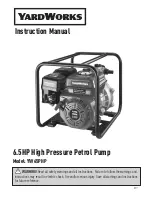
OM-05815
ULTRA V SERIES
PAGE B - 5
INSTALLATION
In
low discharge head
applications
(less than 30
feet or 9 meters), it is recommended that the by
pass line be run back to the wet well, and located 6
inches below the water level or cut‐off point of the
low level pump. In some installations, this bypass
line may be terminated with a six‐to‐eight foot
length of 1-1/4 inch I.D.
smooth‐bore
hose; air
and liquid vented during the priming process will
then agitate the hose and break up any solids,
grease, or other substances likely to cause clog
ging.
A bypass line that is returned to a wet well
must be secured against being drawn into
the pump suction inlet.
It is also recommended that pipe unions be in
stalled at each 90
_
elbow in a bypass line to ease
disassembly and maintenance.
In
high discharge head applications
(more than
30 feet), an excessive amount of liquid may be by
passed and forced back to the wet well under the
full working pressure of the pump; this will reduce
overall pumping efficiency.
Therefore, it is recom
mended that a Gorman‐Rupp Automatic Air Re
lease Valve be installed in the bypass line.
Gorman‐Rupp Automatic Air Release Valves are
reliable, and require minimum maintenance. See
AUTOMATIC AIR RELEASE VALVE
in this section
for information about Gorman‐Rupp Automatic Air
Release Valves. Consult your Gorman‐Rupp dis
tributor, or contact the Gorman‐Rupp Company for
selection of an Automatic Air Release Valve to fit
your application.
If the installation involves a flooded suction such as
a below‐ground lift station, a pipe union and manu
al shut‐off valve may be installed in the bleed line to
allow service of the valve without shutting down the
station, and to eliminate the possibility of flooding.
If a manual shut‐off valve is installed
anywhere
in
the air release piping, it
must
be a full‐opening
ball
type
valve to prevent plugging by solids.
If a manual shut‐off valve is installed in
a bypass line, it must not be left closed
during operation. A closed manual shut‐
off valve may cause a pump which has
lost prime to continue to operate with
out reaching prime, causing dangerous
overheating and possible explosive
rupture of the pump casing. Personnel
could be severely injured
.
Allow an over‐heated pump to com
pletely cool before servicing
.
Do not
re
move plates, covers, gauges, or fittings
from an over‐heated pump. Liquid with
in the pump can reach boiling tempera
tures, and vapor pressure within the
pump can cause parts being disen
gaged to be ejected with great force. Af
ter the pump completely cools, drain
the liquid from the pump by removing
the casing drain plug. Use caution when
removing the plug to prevent injury to
personnel from hot liquid.
AUTOMATIC AIR RELEASE VALVE
When properly installed, a Gorman‐Rupp Auto
matic Air Release Valve will permit air to escape
through the bypass line and then close automati
cally when the pump is fully primed and pumping
at full capacity.
Some leakage (1 to 5 gallons [3.8 to 19
liters] per minute) will occur when the
valve is fully closed. Be sure the bypass
line is directed back to the wet well or
tank to prevent hazardous spills.
Consult the manual accompanying the Air Release
Valve for additional information on valve installation
and performance.













































